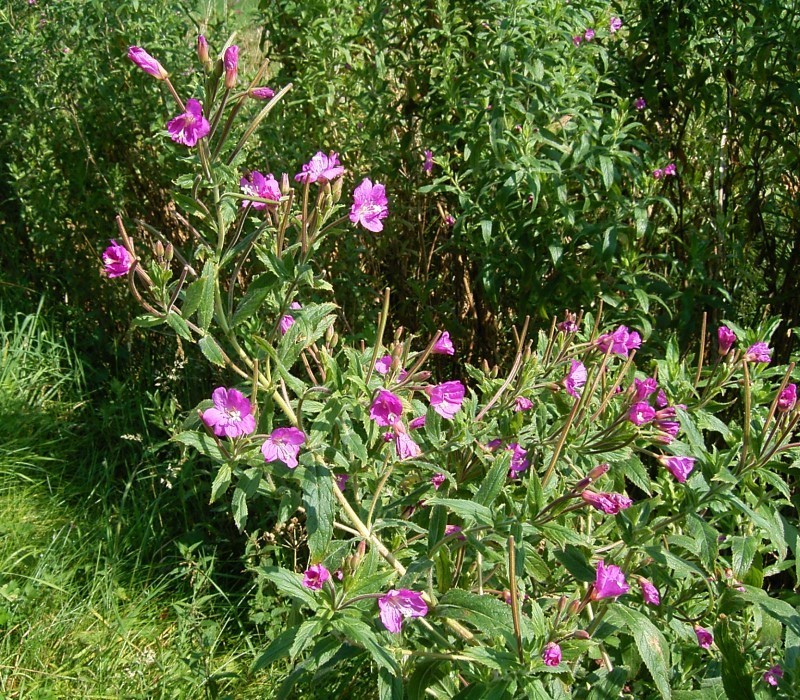Willowherb
(Epilobium)

Description
Epilobium is a genus of flowering plants in the family Onagraceae, commonly known as willowherbs. This genus contains around 200 species of herbaceous plants, which are mostly native to the temperate regions of the Northern Hemisphere. The plants in this genus are known for their attractive flowers and ability to grow in a wide range of soil conditions. Taxonomy The genus Epilobium was first described by the Swedish botanist Carl Linnaeus in 1753. The name "Epilobium" is derived from the Greek words "epi," which means "upon," and "lobos," which means "a pod." This name refers to the fact that the seeds of these plants are contained within a long, slender pod. The plants in this genus are often confused with members of the related genus Chamerion, which was previously classified as part of Epilobium. However, Chamerion species are distinguished from Epilobium species by their flowers, which have four petals instead of the typical Epilobium five. Description The plants in the Epilobium genus are typically herbaceous perennials, although some species are annuals or biennials. The leaves are usually simple, alternate, and lanceolate in shape. The flowers are produced in racemes or spikes, and are typically pink, purple, or white in color. One of the distinguishing features of the plants in this genus is their seed pods, which are long and slender. These pods split open when mature, releasing the numerous seeds contained within. The seeds are often dispersed by wind, which is facilitated by the hairs that cover the seeds. Ecology The ecology of the Epilobium genus is diverse, as the plants are found in a wide range of habitats and can tolerate different soil and moisture conditions. Some of the key ecological features of the Epilobium genus are discussed below: Habitat: Epilobium species can be found in a variety of habitats, including wetlands, meadows, forests, and disturbed areas such as roadsides and fields. Some species, such as Epilobium angustifolium, also known as fireweed, are known for their ability to colonize areas that have been recently burned. Pollination: The flowers of Epilobium species are pollinated by a variety of insects, including bees, butterflies, and moths. The flowers produce nectar, which attracts these insects. Some species, such as Epilobium ciliatum, also known as fringed willowherb, are pollinated by hummingbirds. Seed dispersal: The seeds of Epilobium species are dispersed by wind, which is facilitated by the hairs that cover the seeds. The long, slender seed pods split open when mature, releasing the numerous seeds contained within. Food sources: Many species in this genus are important as food sources for various insects, including bees, butterflies, and moths. The leaves of some species are also eaten by deer and other herbivores. The seeds are eaten by birds and small mammals. Soil: Epilobium species are able to tolerate a wide range of soil conditions, from damp to dry and from acidic to alkaline. Some species, such as Epilobium palustre, also known as marsh willowherb, are found in wetland habitats and are adapted to growing in nutrient-rich soils. Invasive potential: Some species in the Epilobium genus, such as Epilobium hirsutum, also known as great hairy willowherb, can be invasive in certain areas. These plants can outcompete native vegetation and disrupt ecosystems, so it is important to carefully manage their presence in these situations. Overall, the ecology of the Epilobium genus is complex and diverse. These plants are adapted to a wide range of habitats and provide important food sources for various insects and animals. As with all plant species, it is important to carefully manage their presence in order to prevent any negative impacts on the environment. Uses The Epilobium genus has a number of uses, including medicinal, horticultural, and ecological uses. Some of the key uses of this genus are discussed below: Medicinal uses: Several species in the Epilobium genus have been used for medicinal purposes. For example, Epilobium parviflorum, also known as smallflower hairy willowherb, has been traditionally used to treat urinary tract infections and prostate problems. Extracts from this plant have been shown to have anti-inflammatory and antioxidant properties. Some other species have also been used to treat diarrhea, hemorrhoids, and menstrual disorders. Horticultural uses: Epilobium species are commonly used in horticulture, as they are attractive plants with colorful flowers. Some species, such as Epilobium angustifolium, also known as fireweed, are particularly popular in wildflower gardens. These plants are also useful in erosion control and can be used to stabilize soil on steep slopes. Ecological uses: Epilobium species are important for their ecological uses as well. They provide food and habitat for a wide variety of insects and animals, including bees, butterflies, moths, deer, and small mammals. These plants are also important for their ability to colonize disturbed habitats and help restore ecosystems after disturbances such as fires or landslides. Other uses: Some species in the Epilobium genus have been used for other purposes as well. For example, the leaves of Epilobium parviflorum have been used to dye fabrics a yellow color. The plants have also been used to make tea and alcoholic beverages in some cultures. Overall, the Epilobium genus has a wide range of uses and is an important part of many ecosystems. As with all plant species, it is important to carefully manage their presence in order to ensure their continued existence and to prevent any negative impacts on the environment. Conservation Status The conservation status of the Epilobium genus varies depending on the species and the region where they are found. Some species are considered to be of least concern, while others are classified as endangered or vulnerable. For example, Epilobium hirsutum, also known as great hairy willowherb, is considered to be a species of least concern in the United Kingdom, but it is classified as an invasive species in some areas. On the other hand, Epilobium brachycarpum, also known as rock fringe, is listed as an endangered species in the United States. The conservation status of the Epilobium genus is important to consider, as habitat loss and other human activities can threaten the survival of these plants. It is important to monitor and manage populations of these plants to ensure their continued existence and to maintain the health of the ecosystems where they are found. Conclusion The Epilobium genus is a diverse group of plants with attractive flowers and a wide range of ecological and medicinal uses. These plants are found in a variety of habitats, and have adapted to survive in different soil conditions. While some species can be invasive, they are generally considered valuable additions to gardens and natural landscapes. As with all plant species, it is important to carefully manage their presence in order to prevent any negative impacts on the environment.
Taxonomic tree:







